
The Johnson County War, also known as the War on Powder River and the Wyoming Range War, was a range conflict that took place in Johnson County, Wyoming from 1889 to 1893. The conflict began when cattle companies started ruthlessly persecuting alleged rustlers in the area, many of whom were settlers who competed with them for livestock, land and water rights. As violence swelled between the large established ranchers and the smaller settlers in the state, it culminated in the Powder River Country when the former hired gunmen to invade the county. The gunmen's initial incursion in the territory alerted the small farmers and ranchers, as well as the state lawmen, and they formed a posse of 200 men that led to a grueling stand-off. The siege ended when the United States Cavalry on the orders of President Benjamin Harrison relieved the two forces, although further fighting persisted in the following months.

Thomas Horn Jr., was an American scout, cowboy, soldier, range detective, and Pinkerton agent in the 19th-century and early 20th-century American Old West. Believed to have committed 17 killings as a hired gunman throughout the West, Horn was convicted in 1902 of the murder of 14-year-old Willie Nickell near Iron Mountain, Wyoming. Willie was the son of sheep rancher Kels Nickell, who had been involved in a range feud with neighbor and cattle rancher Jim Miller. On the day before his 43rd birthday, Horn was executed by hanging in Cheyenne, Wyoming.

A range war or range conflict is a type of usually violent conflict, most commonly in the 19th and early 20th centuries in the American West. The subject of these conflicts was control of "open range", or range land freely used for cattle grazing, which gave the conflict its name. Typically they were disputes over water rights or grazing rights and cattle ownership.

Frank M. Canton was an American Old West fugitive who had a career as a deputy U.S. marshal under an assumed name. Although an ex-sheriff stock detective in Wyoming, Canton and his associates were accused of operating more by assassination than the law. Extrajudicial measures such as the lynching of Ellen Watson inflamed public opinion against the long-established big ranchers Canton worked for, and to re-establish control over grazing they funded an all-out assault on those small operators considered to be rustlers. Canton directed Frank Wolcott's imported gunmen in their planned vigilante campaign, known as the Johnson County War, which was quickly ended by a local posse. Finding himself a marked man in Wyoming, Canton considered it opportune to leave the state. He spent most of the rest of his working life in law enforcement for the court of hanging judge Isaac Parker.

Cattle drives were a major economic activity in the 19th and early 20th century American West, particularly between 1850s and 1910s. In this period, 27 million cattle were driven from Texas to railheads in Kansas, for shipment to stockyards in Louisiana and points east. The long distances covered, the need for periodic rests by riders and animals, and the establishment of railheads led to the development of "cow towns" across the frontier.

Commodore Perry Owens was an American lawman and gunfighter of the Old West. One of his many exploits was the Owens-Blevins Shootout in Arizona Territory during the Pleasant Valley War.
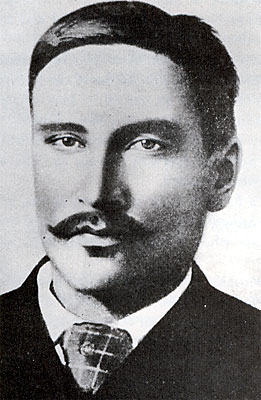
The Pleasant Valley War, sometimes called the Tonto Basin Feud, or Tonto Basin War, or Tewksbury-Graham Feud, was a range war fought in Pleasant Valley, Arizona in the years 1882–1892. The conflict involved two feuding families, the Grahams and the Tewksburys. The Grahams were ranchers, while the Tewksburys, who were part Native American, started their operations as cattle ranchers before branching out to sheep.

Heaven with a Gun is a 1969 American Western film starring Glenn Ford and directed by Lee H. Katzin.

Jackson Lee "Diamondfield Jack" Davis was pardoned for the 1896 Deep Creek Murders in Idaho and would later strike it rich in Nevada, where he established several mining towns, one named after his nickname "Diamondfield".
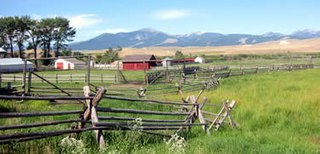
A ranch is an area of land, including various structures, given primarily to ranching, the practice of raising grazing livestock such as cattle and sheep. It is a subtype of farm. These terms are most often applied to livestock-raising operations in Mexico, the Western United States and Western Canada, though there are ranches in other areas. People who own or operate a ranch are called ranchers, cattlemen, or stockgrowers. Ranching is also a method used to raise less common livestock such as horses, elk, American bison, ostrich, emu, and alpaca.

Empire Ranch is a working cattle ranch in southeastern Pima County, Arizona, that was placed on the National Register of Historic Places in 1976. In its heyday, Empire Ranch was one of the largest in Arizona, with a range spanning over 180 square miles (470 km2), and its owner, Walter L. Vail, was an important figure in the establishment of southern Arizona's cattle industry. It is currently owned by the Bureau of Land Management with a grazing lease to a private operator.
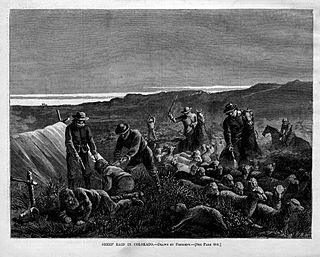
The sheep wars, or the sheep and cattle wars, were a series of armed conflicts in the Western United States fought between sheepmen and cattlemen over grazing rights. Sheep wars occurred in many western states, though they were most common in Texas, Arizona, and the border region of Wyoming and Colorado. Generally, the cattlemen saw the sheepherders as invaders who destroyed the public grazing lands, which they had to share on a first-come, first-served basis. Between 1870 and 1920, approximately 120 engagements occurred in eight states or territories. At least 54 men were killed and some 50,000 to over 100,000 sheep were slaughtered.

The Deep Creek murders were the culmination of a minor sheep war in the borderlands of Idaho and Nevada in 1896. On or about February 4, 1896, two Mormon sheepherders were killed by an unknown assailant while they were camping along a creek in what was then part of Cassia County, Idaho.

In the Western United States and Canada, open range is rangeland where cattle roam freely regardless of land ownership. Where there are "open range" laws, those wanting to keep animals off their property must erect a fence to keep animals out; this applies to public roads as well. Land in open range that is designated as part of a "herd district" reverses liabilities, requiring an animal's owner to fence it in or otherwise keep it on the person's own property. Most eastern states and jurisdictions in Canada require owners to fence in or herd their livestock.

Aztec Land and Cattle Company, Limited ("Aztec") is a land company with a historic presence in Arizona. It was formed in 1884 and incorporated in early 1885 as a cattle ranching operation that purchased 1,000,000 acres in northern Arizona from the Atlantic & Pacific Railroad. It then imported approximately 32,000 head of cattle from Texas and commenced ranching operations in Arizona. Because Aztec's brand was the Hashknife, a saddler's knife used on early day ranches, the company was known more famously as The Hashknife Outfit. The company has been in continuous existence since 1884.

The Spring Creek raid, also known as the Tensleep Murders or the Tensleep Raid, occurred in 1909 and was the last serious conflict during the Sheep Wars in Wyoming, as well as the deadliest sheep raid in the state's history. On the night of April 2, the sheepherder Joe Allemand and four of his associates were encamped along Spring Creek, near the town of Ten Sleep, when a group of seven masked cattlemen attacked them. It remains uncertain as to whether or not an exchange of gunfire took place between the two parties, but evidence suggests that Allemand and two of his men were executed while the remaining two escaped unharmed. Two sheep wagons were also destroyed by fire and about two dozen head of sheep were shot to death. Seven men were arrested for the crime, two of whom turned state's evidence and were acquitted. The rest were found guilty and sent to prison for sentences ranging from three years to life in prison. The conviction of the Tensleep murderers effectively put an end to the killings on the open range and exemplified the arrival of law and order in a region that still retained its rugged frontier environment after the end of the 19th century. Although there continued to be sheep raids in Wyoming into the 1910s, there were no more deaths.
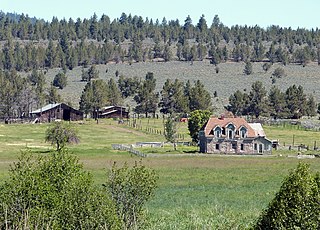
The Roba Ranch is a pioneer ranch located near the small unincorporated community of Paulina in Crook County, Oregon. The ranch is named for George and Mary Roba, sheep ranchers who acquired the property in 1892. Most of the important ranch buildings were constructed by the Roba family between about 1892 and 1910. Today, the ranch covers 1,480 acres (6.0 km2) and is privately owned. The ranch was listed on the National Register of Historic Places in 2007.
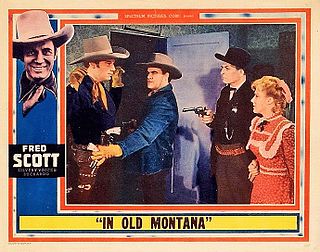
In Old Montana is a 1939 American Western film directed by Raymond K. Johnson and starring Fred Scott, Jean Carmen and John Merton. It is about the conflict existing between sheepherders and cattlemen in the nineteenth century.

William Walter Brown was an American pioneer rancher in central Oregon. He owned two large ranches between Burns and Prineville, Oregon. Together, his properties comprised one of the largest privately owned sheep and horse operations in the United States. He was known as the Horse King of the West and the Millionaire Horse King because over 10,000 horses carried his Horseshoe Bar brand. Brown was also a well-known philanthropist who gave hundreds of thousands of dollars to a wide range of religious and educational institutions.

The Pecos War, also known as the War of the Pecos and the Chisum War, was a range war fought by cattle baron John Chisum against neighboring small ranchers, farmers, and Native Americans from 1876-1877 along the Pecos River in New Mexico. The conflict was caused primarily by competition: Chisum believed that his livestock and other resources were being depleted upon by people he alleged to be rustlers. At the same time, Chisum was also fighting Mescalero Apaches from the nearby reservations who were said to prey on his herds.




















